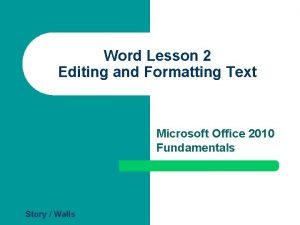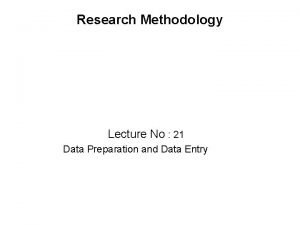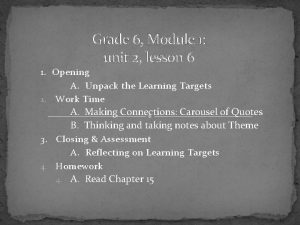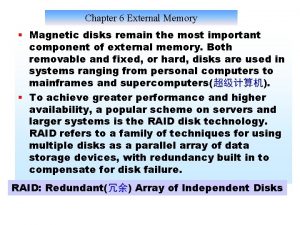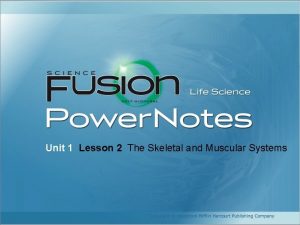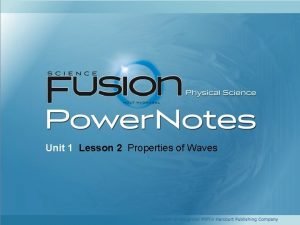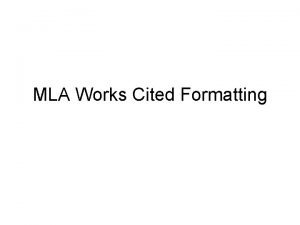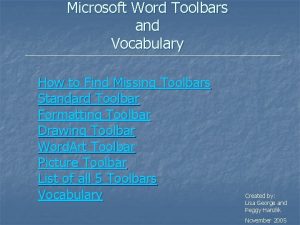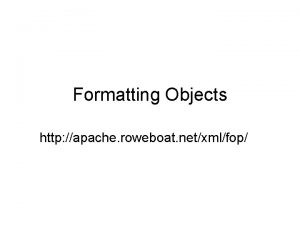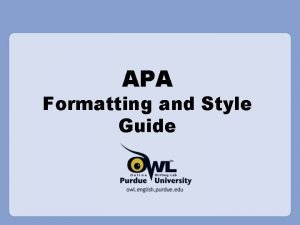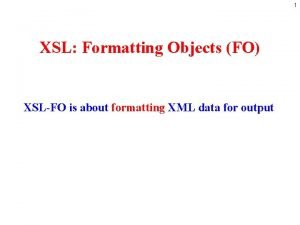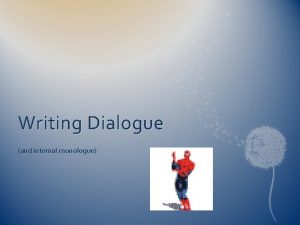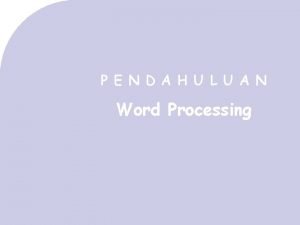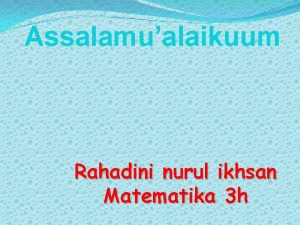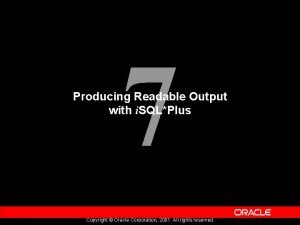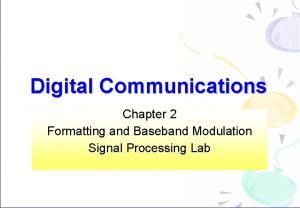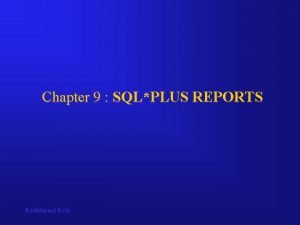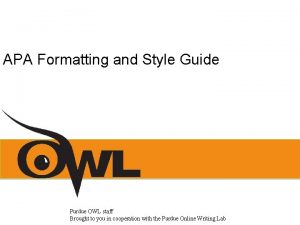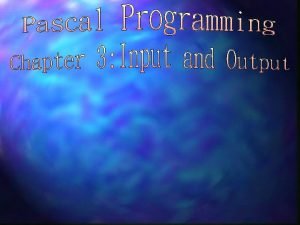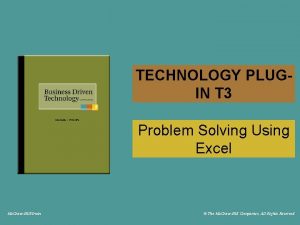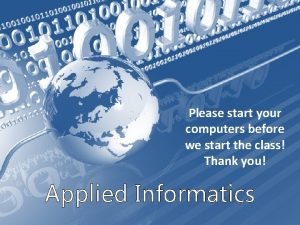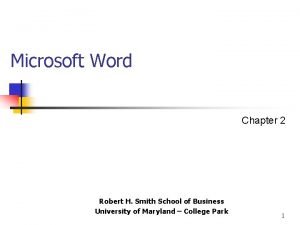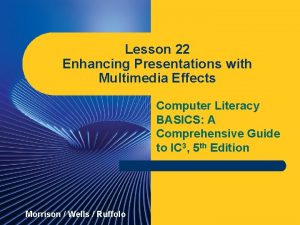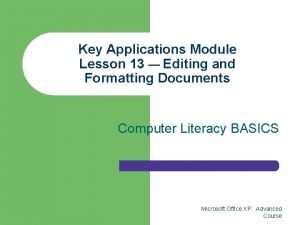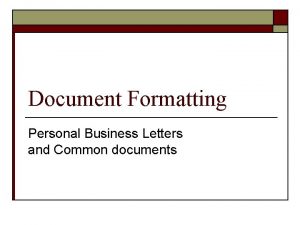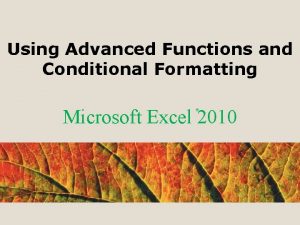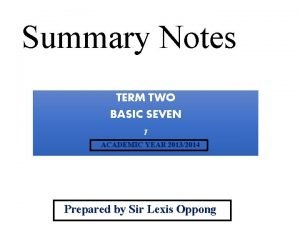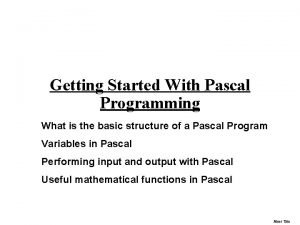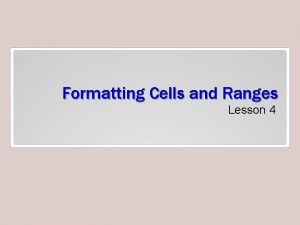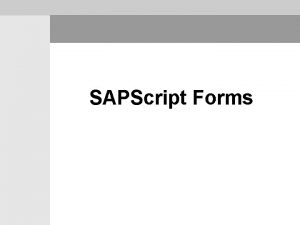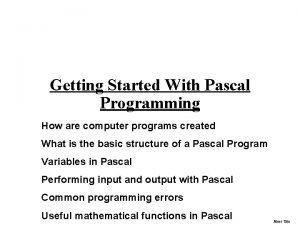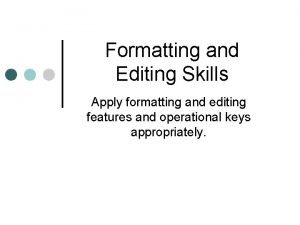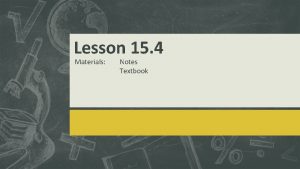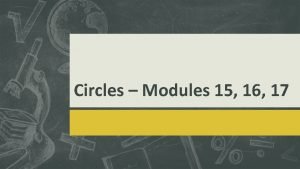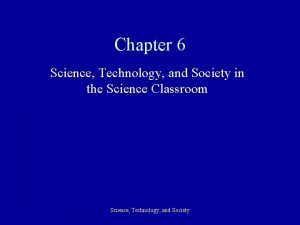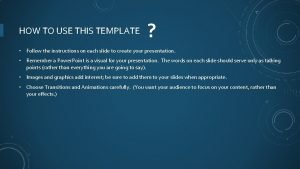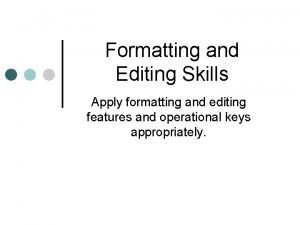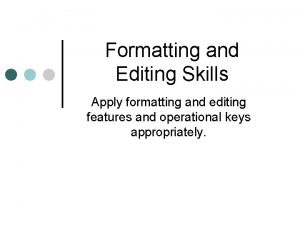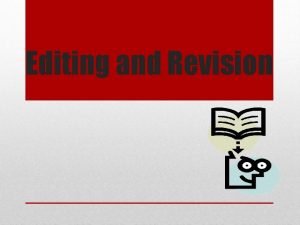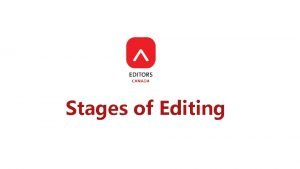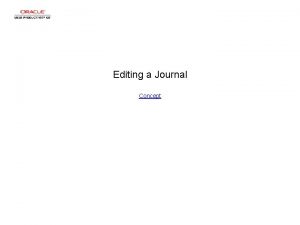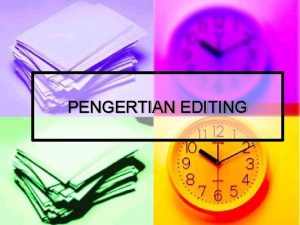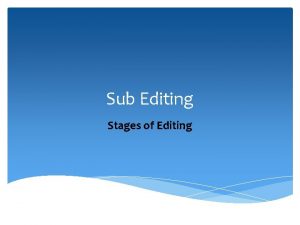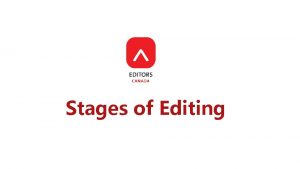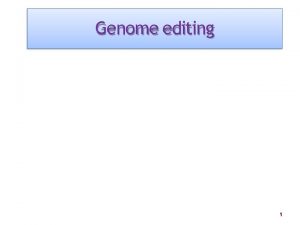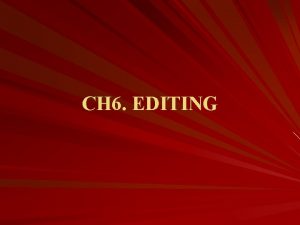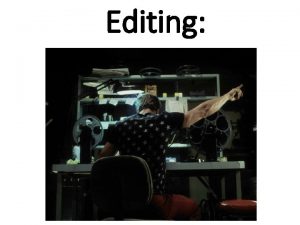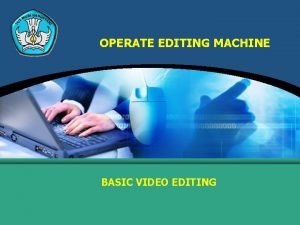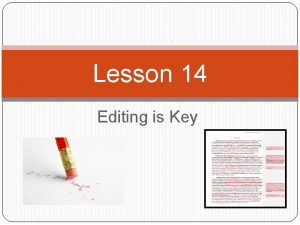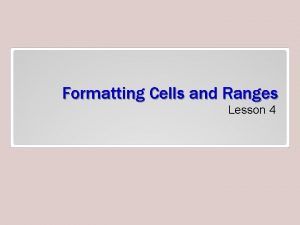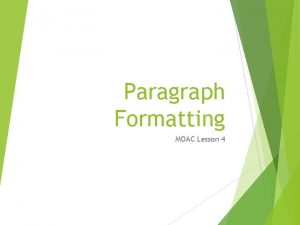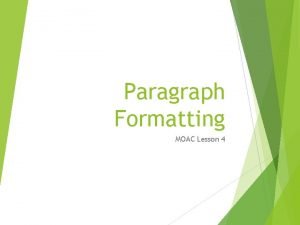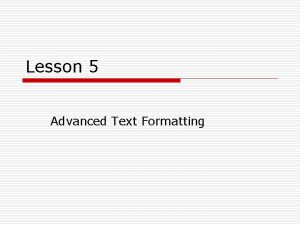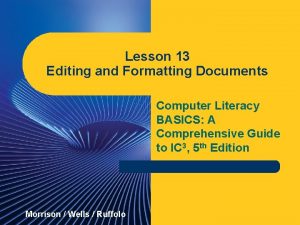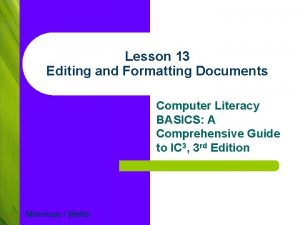Key Applications Module Lesson 13 Editing and Formatting




















































- Slides: 52

Key Applications Module Lesson 13 — Editing and Formatting Documents Computer Literacy BASICS Microsoft Office XP: Advanced Course

Objectives l l 2 Delete and insert text using the Backspace and Delete keys and Insert and Overtype mode. Use the Undo and Redo features. Edit text using drag-and-drop editing and the cut, copy, and paste commands. Find and replace text. Computer Literacy BASICS

Objectives (cont. ) l l 3 Format text with fonts, line spacing, alignment, tabs and indents, page breaks, and bulleted and numbered lists. Check and correct spelling and grammar. Display document statistics, such as word count. Use Print Preview and format a document for printing. Computer Literacy BASICS

Vocabulary l l l l 4 Alignment Attributes Clipboard Drag-and-drop First line indent Format Painter l l l l Hanging indent Hard page break Insert mode Landscape orientation Overtype mode Points Portrait orientation Soft page break Computer Literacy BASICS

Deleting Characters You can delete characters one character at a time by l Using the Backspace key – l Using the Delete key – l 5 This deletes the character to the left of the insertion point each time the key is pressed. This deletes the character to the right of the insertion point each time the key is pressed. Holding down either key will continue to delete characters until the key is released. Computer Literacy BASICS

Inserting Characters l Word enters text in Insert mode by default. – l Turning off Insert mode activates Overtype mode. – l When you type new text, it replaces existing text. Toggle between these modes by – – 6 When you type new text in front of existing text, the existing text shifts to the right to make room for the new text. Double-clicking OVR in the status bar Pressing the Insert key on the keyboard Computer Literacy BASICS

Undo, Redo, and Repeat l l 7 The Undo command on the Edit menu (or the Undo button) can be used to reverse the last edit that you made to the text or document. The Redo command on the Edit menu (or the Redo button) can be used to reverse an Undo action. You can use the Repeat command on the Edit menu to repeat your last action or edit. Shortcut keys for these commands are Ctrl + Z for Undo and Ctrl + Y for Redo or Repeat. Computer Literacy BASICS

Undo and Redo Commands The Undo and Redo buttons are on the Standard toolbar. To Undo and Redo multiple steps at one time, select an action in the Undo list, and that action and all actions above it will be undone. 8 Undo Redo Click the drop-down arrow to the right of the Undo or Redo button on the Standard toolbar to display a command list box. Computer Literacy BASICS

Copying and Moving Text l Selected text can be copied or moved from its location in the active document to – – – l The most common methods of doing this are – – 9 Some other location in the active document Some other Word document Some other application’s document Drag-and-drop editing Cut, Copy, and Paste commands Computer Literacy BASICS

Drag-and-Drop Editing l l Drag-and-drop is very efficient when moving text a short distance. To use this method: – – l 10 Select the text to be moved. Press and hold down the mouse button. Drag the text to its new location. Release the mouse button. You can also copy text in this way by holding down the Ctrl key as you drag. Computer Literacy BASICS

Cut, Copy, and Paste Commands l The Cut, Copy, and Paste commands can be activated by clicking their respective buttons on Copy the toolbar. Cut l l 11 Paste The commands can also be found on the Edit menu. Shortcut keys for these commands are Ctrl + C for Copy, Ctrl + X for Cut, and Ctrl + V for Paste. Computer Literacy BASICS

Cut, Copy, and Paste Commands (cont. ) l l 12 Cut is used to remove selected text from the document. Copy is used to copy selected text. Cut and copied text is placed on the Clipboard, a temporary storage area. Paste is used to insert text from the Clipboard back into the document at the location of the insertion point. Computer Literacy BASICS

The Clipboard l l 13 The Clipboard is a shared item among all Office applications and can hold data of all Office types. You can paste an item on the Clipboard into any Office application. The Clipboard can hold up to 24 items. To view the Clipboard task pane shown at right, select the Task Pane option on the View menu. You may need to click the down arrow at the top right of the task pane and then select Clipboard if it does not automatically display. Computer Literacy BASICS

Inserting Special Text l l 14 The Insert menu in Word offers options to insert the current date, time, or special symbols in your document. The text will be inserted at the place in the document where the insertion point is positioned, so be sure you have the insertion point in the place where you want the special text to appear or you will have to cut and move the inserted text. Computer Literacy BASICS

The Date and Time Dialog Box l l 15 Options in the Date and Time dialog box allow you to enter the current date and time as text. So, if you open the document the next day, the previous day’s date will appear. You also can insert a field that will always show the current date or time by selecting the Field option from the Insert menu. Computer Literacy BASICS

The Symbol Dialog Box l l 16 Use the Symbol command on the Insert menu to open the Symbol dialog box. The Special Characters tab in the Symbol dialog box allows you to insert dashes, copyright and trademark symbols, and nonbreaking spaces. Computer Literacy BASICS

Finding Text l l l 17 Use Word’s Find command to search for one or all occurrences of a word or phrase in your document. Select the Find command on the Edit menu to open the Find and Replace dialog box. Enter the word or phrase to find in the text box and then click the Find Next button. Each time you click Find Next, Word will search for another occurrence. Computer Literacy BASICS

Replacing Text l l l 18 Use the Replace feature to search for text and replace it with new text. Select the Replace command on the Edit menu to open the Replace tab in the Find and Replace dialog box. Enter the Find criteria, enter the Replace with criteria, and click the Find Next button. Click Replace and Find Next or just Find Next to selectively replace text, or click Replace All to replace all occurrences. Computer Literacy BASICS

The Replace Tab in the Find and Replace Dialog Box 19 Computer Literacy BASICS

Formatting Text l l l Formats are applied to text to manipulate the appearance of the text. You can change the size, font, attributes, indents, or list styles when you add a format to text. There are three categories of formats in Word: – – – 20 Character formats, such as text color and underline Paragraph formats, such as line spacing and alignment Document formats, such as paper orientation and margins Computer Literacy BASICS

Character Formats: Fonts l l 21 A font is the design of a typeface. Fonts come in many styles, and you can use more than one font in a document. The size of the type is measured in points (the larger the point size, the bigger the text). Use the Formatting toolbar to change the font, attribute, or size for selected text. Computer Literacy BASICS

The Font Dialog Box 22 Computer Literacy BASICS

Character Formats: Attributes l l l 23 The Font dialog box also lists font attributes such as Regular, Italic, Bold, and Bold italic. You can change many more attributes such as color, outline, and shadow. The Formatting toolbar also provides buttons to quickly change the attributes of text and drop-down list boxes to change the font and size of the text without opening a dialog box. Computer Literacy BASICS

Paragraph Formats: Line Spacing l The default line spacing in Word is single spacing. – – 24 When text is double-spaced, there is a blank line between text lines. The blank line between text lines is half the space for 1½-line spacing. Computer Literacy BASICS

Paragraph Formats: Line Spacing (cont. ) l You can change line spacing by – – l 25 Using the Line Spacing button on the Formatting toolbar. Clicking the Format menu, clicking Paragraph, and then changing the spacing option in the Paragraph dialog box. You can also adjust the spacing before and after paragraphs in the Paragraph dialog box. Computer Literacy BASICS

Paragraph Formats: Alignment l l Alignment refers to how text is positioned between the margins. Line Spacing You can select from four alignments: – – l 26 Left Center Right Justified Alignment options You can quickly set any of these options by selecting the text and using the buttons (shown above) on the Formatting toolbar. Computer Literacy BASICS

Displaying the Ruler l You will usually see a ruler at the top of the document window in Word. – l l 27 If you do not see it, make sure that Ruler is selected in the View menu. The Ruler is a handy reference to see the “true” size of your text and document. It can also be used to quickly set tabs, indents, and margins in your document. Computer Literacy BASICS

Paragraph Formats: Tabs l l Tabs are used to indent text and to line up columns of data. Word’s default tabs are set at half-inch intervals. You can set custom tabs using tab markers and the Ruler. You can set left, center, right, and decimal tabs. Change tab symbols here 28 Left Tab Center Tab Right Tab The Ruler displays at the top of a Word document. Decimal Tab Computer Literacy BASICS

Paragraph Formats: Indents l l l 29 An indent is a space between the margin First Line and where the text appears. Indent marker Text can be indented from the left or Hanging right margin, or from both. Indent You can create first line indents. marker You can create hanging indents. Left Indents are set by dragging indent markers (at right) along the ruler. Computer Literacy BASICS

Inserting Page Breaks l l A soft page break is automatically inserted for you when you fill a page with text or graphics. You can also break pages manually by inserting a hard page break, which forces a page break at a specific location. – – 30 To insert a hard page break, select Break from the Insert menu and then select the Page break option in the Break dialog box. Or you can use the shortcut key combination for inserting a hard page break, Ctrl + Enter. Computer Literacy BASICS

Page Breaks and Section Breaks l In Normal view, a page break displays as a dotted line. – – l l 31 In Page Layout and Reading Layout views, the pages actually look like separate sheets of paper. You may not see any indication of page breaks in Web Layout and Outline views. In addition to page breaks, you can also insert section breaks in your documents. A section break allows you to vary the layout of a document within a page or between pages. Computer Literacy BASICS

Bullets and Numbers l Create lists using bullets and numbers. – – l Select the text and click the Bullets or Numbering button on the Formatting toolbar to create the list. – – 32 Bullet lists are called unordered lists since the order does not matter. Numbered lists are called ordered lists since they have a sequence number. Both lists are automatically formatted with a hanging indent. You can change the bullet or number style in the Bullets and Number dialog box on the Format menu. Computer Literacy BASICS

The Format Painter l To apply multiple character formats quickly to text in several places in your document, use the Format Painter button to copy all formatting to other text. – – l 33 Select the text with the formatting you want to copy. Format Painter Double-click the Format Painter button on the Standard toolbar. When the pointer changes to a button paintbrush, click the text where you want to apply the formatting. To apply formatting to a group of words, drag the pointer across the words to select them. Computer Literacy BASICS

Document Statistics Tools l l l 34 The Word Count command on the Tools menu opens the Word Count dialog box. This dialog box provides statistics about a document including the number of words, pages, sentences, lines, and characters. You can see all the options for available statistics in the drop-down list in the Word Count dialog box. Computer Literacy BASICS

The Word Count Toolbar Click the Show Toolbar button in the Word Count dialog box to display the Word Count toolbar. 35 To hide the Word Count toolbar, click the toolbar’s Close button. Click Recount to view updated statistics about the document. Computer Literacy BASICS

Checking Spelling and Grammar l Word has a spell checker that can be used to search for misspelled words in your document. – l It also has a grammar checker to look for common grammar mistakes. – l 36 Misspelled words are indicated in text with a red wavy underline. Grammar mistakes are underlined in the document with a green wavy line. Right-click an underline to view suggestions for changes to correct an error. Computer Literacy BASICS

Spelling and Grammar Options l 37 To check the entire document for spelling and/or grammar errors, open the Spelling and Grammar dialog box by clicking the Spelling and Grammar option on the Tools menu. Click the Options button in the Spelling and Grammar dialog box to access the Options dialog box (at right) to change the settings for the spelling and grammar checking tools. Computer Literacy BASICS

Page Orientation and Margins l Documents can be oriented two ways: – – – l Margins are the blank space around the edges of the document. – – 38 Portrait: The document is taller than it is wide. Landscape: The document is wider than it is tall. Set either option by selecting the Page Setup option on the File menu. The default margins are 1 inch for top and bottom margins and 1. 25 inches for left and right margins. Margins can also be set in the Page Setup dialog box. Computer Literacy BASICS

Print Preview l l l 39 To avoid wasteful printing, preview your document and make adjustments before you print it. Print Preview is an on-screen, reduced view of the layout of a completed page or pages. Click the Print Preview button on the Standard toolbar to see how your document will look when printed. Computer Literacy BASICS

Print Preview (cont. ) l l l 40 Preview mode shows you page orientation, margins, and page breaks. If you notice any errors, you can edit the document in Print Preview or return to Normal view to correct the errors. At the top of the Print Preview window, you will see the toolbar shown below with tools you can use in preview mode. Computer Literacy BASICS

Selecting a Printer l l l 41 The default printer for your computer system is listed in the text box at the top of the Print dialog box. To temporarily change the printer, click the down arrow to the right of the text box and then click the name of another printer. Selecting a different printer from the list gives you the flexibility to use any printer available to your system to print a job. Computer Literacy BASICS

Fixing Common Printing Problems l l l 42 Use True. Type fonts, which look the same on the printed page as on the screen. Check that you are using valid print settings, such as margins that are within the print area of your printer. Make sure your printer is online and is correctly connected to your computer. Computer Literacy BASICS

Fixing Common Printing Problems (cont. ) l l 43 Open the Print dialog box to confirm that the correct printer is selected in the Printer Name text box. Use Windows’ Printing Troubleshooter (in Help and Support) to determine whether your printer setup is correct. Computer Literacy BASICS

Summary l l l 44 The Delete key and the Backspace key can be used to delete characters. When you add new text in Insert mode, the new characters are inserted between existing text. When text is entered in Overtype mode, the new text replaces existing text. The Undo and Redo commands make editing easy when you make mistakes or change your mind. Computer Literacy BASICS

Summary (cont. ) l l 45 The Repeat command lets you repeat your most recent action. Selected text can be copied or moved from one location in a Word document to a new location in the same document, to a different Word document, or to another application. Drag-and-drop editing is especially helpful when you are moving or copying text short distances. Computer Literacy BASICS

Summary (cont. ) l l 46 When you use the Cut, Copy, and Paste commands, Word stores the selected text in the Clipboard. The Clipboard stores up to 24 items. The Find command makes searching for text and/or formats easy. The Replace command replaces multiple occurrences of text automatically. Computer Literacy BASICS

Summary (cont. ) l l l 47 Fonts are available in a variety of styles and point sizes. Attributes such as bold, italic, underline, small caps, and color can be added to text, and more than one attribute can be applied to the same text. You can adjust the line spacing in a paragraph to create more or less white space between the lines of text. Computer Literacy BASICS

Summary (cont. ) l l l 48 Formatting the paragraph alignment for left, center, right, or justified positions the text appropriately between the left and right margins. Custom tabs can be set by clicking on the Ruler. Options for indenting text include left indents, right indents, first line indents, and hanging indents. Computer Literacy BASICS

Summary (cont. ) l l 49 Word automatically adds a soft page break when you fill a page, but you can add a hard page break to force a new page to start at any point in a document. The Bullets and Numbering feature automatically adds and formats bullets and numbers in lists. Computer Literacy BASICS

Summary (cont. ) l l 50 Document statistics provide information about the number of words, pages, lines, paragraphs, and sentences in the Word Count dialog box. Word checks spelling and grammar as you key text. Misspelled words are marked with red wavy lines and possible grammar errors are marked with green wavy lines. Spelling and grammar errors can be corrected as you enter text by using a shortcut menu. Computer Literacy BASICS

Summary (cont. ) l l 51 To check all spelling and grammar at once, use the Spelling and Grammar dialog box. The page orientation determines how the document will print on the page. Adjusting the margins affects the white space around the edges of the page. Computer Literacy BASICS

Summary (cont. ) l 52 Print Preview shows a reduced view of the layout of a document. You can also reduce the view of a document by changing the zoom. Print Preview can help eliminate wasteful printing. Computer Literacy BASICS
 Arrow font
Arrow font Data preparation process in research methodology
Data preparation process in research methodology Nonlinear video editing
Nonlinear video editing Grade 6, module 1: unit 2 answer key
Grade 6, module 1: unit 2 answer key Lesson outline lesson 1 solids liquids and gases answer key
Lesson outline lesson 1 solids liquids and gases answer key Lesson outline lesson 3 eclipses and tides answer key
Lesson outline lesson 3 eclipses and tides answer key Data organization and formatting of magnetic disk
Data organization and formatting of magnetic disk Quote citation
Quote citation C device module module 1
C device module module 1 Lesson outline lesson 2 aquatic ecosystems answer key
Lesson outline lesson 2 aquatic ecosystems answer key Lesson outline lesson 3 weather forecasts answer key
Lesson outline lesson 3 weather forecasts answer key Lesson outline physical properties lesson 2
Lesson outline physical properties lesson 2 Lesson 1 climates of earth
Lesson 1 climates of earth Measurement and scientific tools lesson 2 answer key
Measurement and scientific tools lesson 2 answer key Lesson 2 muscle storyboard
Lesson 2 muscle storyboard Wave properties lesson 2
Wave properties lesson 2 Key concept builder lesson 1 what are waves answer key
Key concept builder lesson 1 what are waves answer key Tripadvisor business model canvas
Tripadvisor business model canvas Business model canvas tripadvisor
Business model canvas tripadvisor Apa introduction paragraph example
Apa introduction paragraph example Owl mla works cited
Owl mla works cited Formatting toolbar in ms word
Formatting toolbar in ms word Block style vs modified block style
Block style vs modified block style Formatting objects processor
Formatting objects processor Abstract page apa
Abstract page apa Match destination formatting excel
Match destination formatting excel Xsl-fo
Xsl-fo Internal monologue writing
Internal monologue writing Gambar toolbar formatting
Gambar toolbar formatting Gambar toolbar formatting
Gambar toolbar formatting Sqlplus format output
Sqlplus format output Word study guide template
Word study guide template Formatting in digital communication
Formatting in digital communication Sqlplus report formatting
Sqlplus report formatting Apa format in text citations
Apa format in text citations Pascal writeln formatting
Pascal writeln formatting Text box formatting
Text box formatting Status bar in word 2016
Status bar in word 2016 Paragraph formatting
Paragraph formatting Enhancing a presentation with multimedia
Enhancing a presentation with multimedia Paragraph formatting
Paragraph formatting 5 parts of the letter
5 parts of the letter What is an unqualified structured reference in excel
What is an unqualified structured reference in excel Font name
Font name Pascal writeln format
Pascal writeln format A named group of formatting characteristics
A named group of formatting characteristics Sapscript form
Sapscript form Pascal algorithm examples
Pascal algorithm examples Formatting skills
Formatting skills Module 15 angles and segments in circles answer key
Module 15 angles and segments in circles answer key Module 16 arc length and sector area answer key
Module 16 arc length and sector area answer key Science technology and society module answer key
Science technology and society module answer key Template editing instructions and feedback
Template editing instructions and feedback
